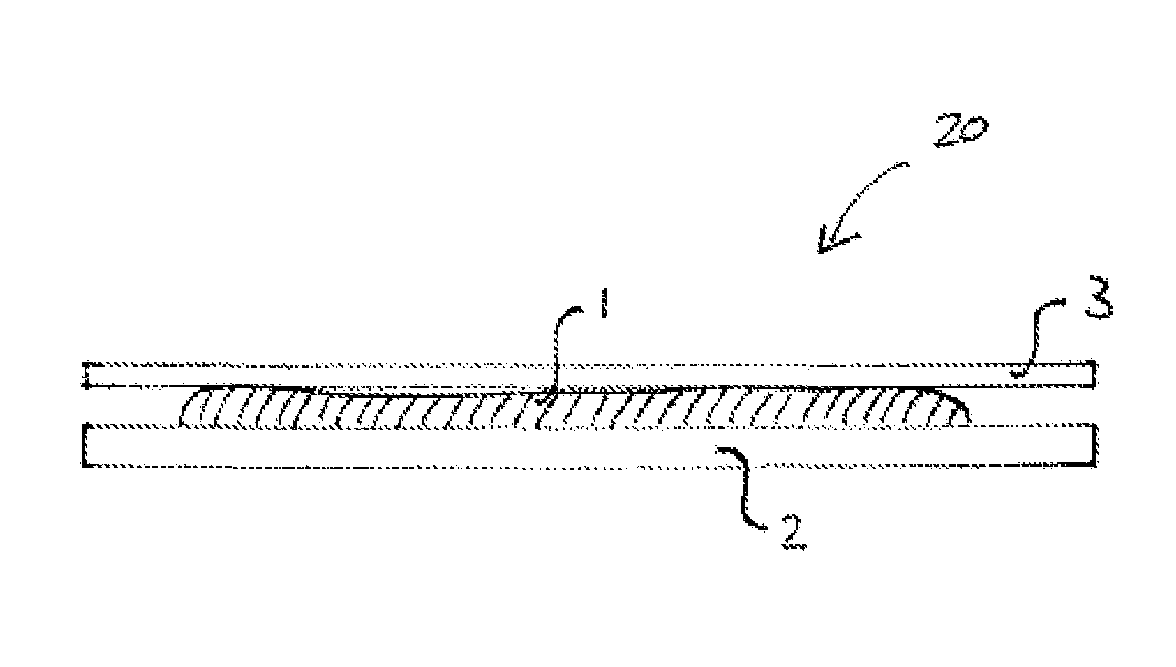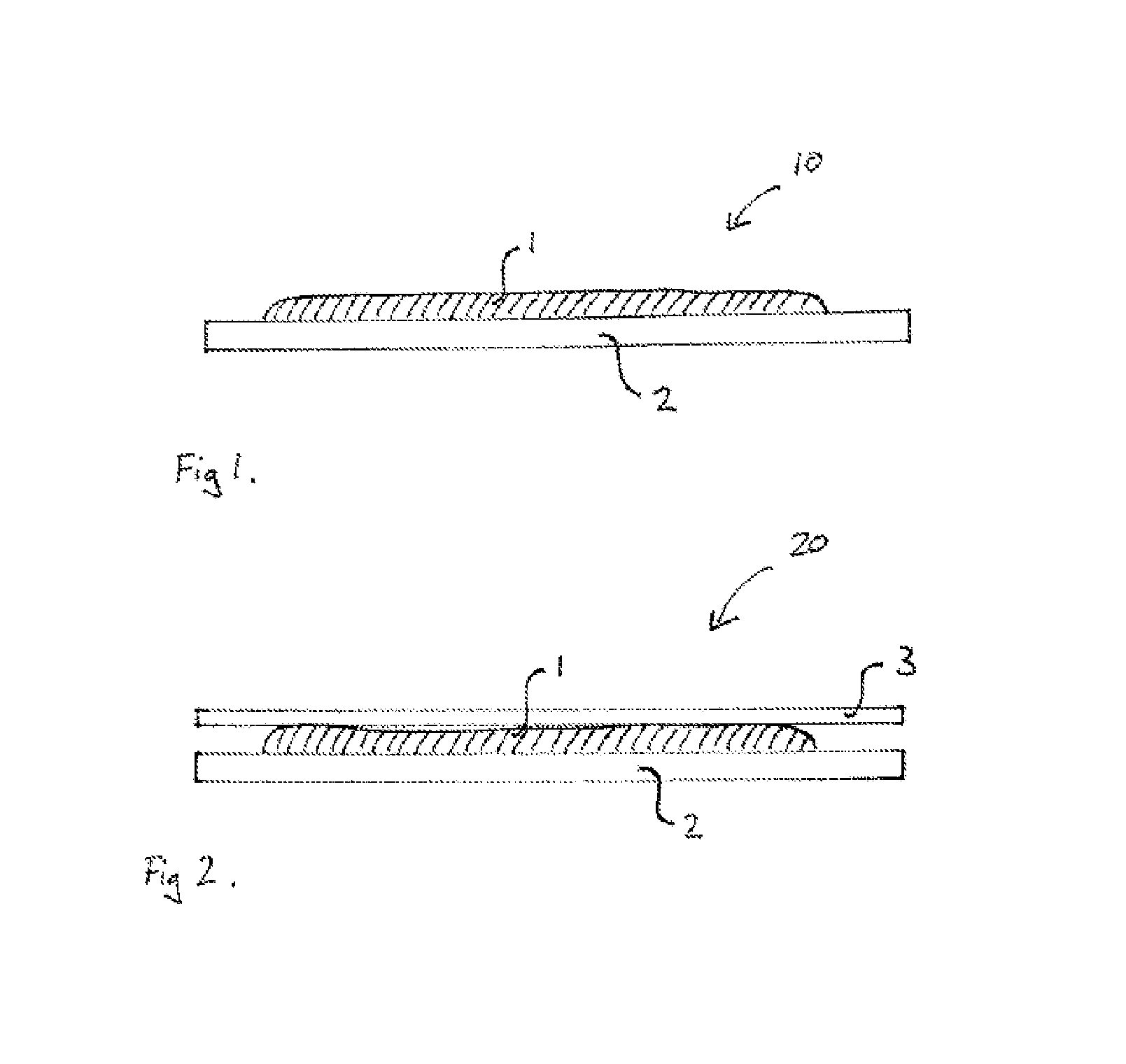Carbon dioxide barrier coating
a technology of carbon dioxide and barrier coating, which is applied in the direction of packaging foodstuffs, packaging goods, transportation and packaging, etc., can solve the problems of loss of gas barrier properties, poor flex resistance, and fragile inorganic coating layers, so as to prolong the shelf life of an article and delay the deterioration of an article
- Summary
- Abstract
- Description
- Claims
- Application Information
AI Technical Summary
Benefits of technology
Problems solved by technology
Method used
Image
Examples
example 1
[0076](a) A solution containing 1.2 parts of Mowiol 4-98, a polyvinyl alcohol, and 6.8 parts of Exceval AQ4104, an EVOH copolymer, (both supplied by Kuraray America, Inc.) in 20 parts of n-propanol and 72 parts of deionised water was prepared by heating, with stirring, the mixture to 80° C., until all the polymer had dissolved.[0077](b) A clay dispersion was prepared by blending 3 parts of Cloisite Na+ (ex. Southern Clay) in 30 parts of iso-propanol and then adding 67 parts of deionised water. 500 g of a clay dispersion according to this formulation was prepared using a Dispermat CV laboratory cavitation type mixer equipped with a 4 cm blade, at a speed of 2500 rpm. The clay was dispersed for 45 minutes.[0078]A coating was then prepared by blending 50 parts of (a) with 50 parts of (b) using a cavitation type mixer.
[0079]The coating was applied to corona discharge treated 12 micron Mylar 800 on a gravure press to achieve a dry film weight of approximately 0.28 g / m2.
[0080]The carbon d...
example 2
[0081](a) A solution containing 8.07 parts of Exceval AQ4104, 8.83 parts of Sokalan CP13s (a polycarboxylic acid, ex. BASF), 30 parts of n-propanol and 53.1 parts of deionised water was prepared by heating and mixing all the components, bar the Sokalan CP13s, until the polymer had dissolved. Once the solution had cooled the Sokalan CP13S was added.[0082](b) A clay dispersion was prepared by blending 4.0 parts of Cloisite Na+ (ex. Southern Clay) in 20 parts of ethanol and then adding 66 parts of deionised water to a total of 500 g. The clay was dispersed using a vortex type mixer (Silverson L4R), equipped with a 1 cm screen at 50% of the maximum power for 45 minutes. After 45 minutes, 10 pats of ethanol were added to the dispersion.[0083](c) A coating was then prepared by blending 33.3 parts of (a) with 66.7 parts of (b) using a cavitation type mixer.
[0084]The coating was applied to corona discharge treated Mylar 800 using both a gravure press and a flexo press to achieve the dry fil...
example 3
Comparative
[0086](a) A solution containing 8.0 parts of Mowiol 4-98 (supplied by Kuraray) in 20 parts of n-propanol and 72 parts of deionised water was prepared by heating, with stirring, the mixture to 80° C., until all the polymer had dissolved.
[0087]A coating was then prepared by blending 50 parts of (a) with 50 parts of the clay dispersion (b) of Example 1 using a cavitation type mixer. The coating was applied to corona discharge treated Mylar 800 using a No. 1 K-Bar.
[0088]The oxygen and carbon dioxide barriers of the coated substrate were then determined and are shown in Table 2. Although the carbon dioxide transmission rate (CDTR) for Example 3 is not significantly different from Example 1, it should be noted that this test was carried out at 0% relative humidity. However, the oxygen transmission rate (OTR), performed at 75% relative humidity indicates that the inclusion of Exceval AQ4104, an EVOH type polymer having less than 20 mol. % ethylene content, in Example 1 provides ...
PUM
| Property | Measurement | Unit |
|---|---|---|
| RH | aaaaa | aaaaa |
| RH | aaaaa | aaaaa |
| thick | aaaaa | aaaaa |
Abstract
Description
Claims
Application Information
 Login to View More
Login to View More - R&D
- Intellectual Property
- Life Sciences
- Materials
- Tech Scout
- Unparalleled Data Quality
- Higher Quality Content
- 60% Fewer Hallucinations
Browse by: Latest US Patents, China's latest patents, Technical Efficacy Thesaurus, Application Domain, Technology Topic, Popular Technical Reports.
© 2025 PatSnap. All rights reserved.Legal|Privacy policy|Modern Slavery Act Transparency Statement|Sitemap|About US| Contact US: help@patsnap.com



